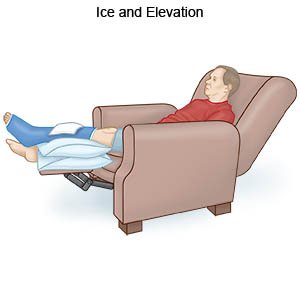Patellar Tendinitis
Medically reviewed by Drugs.com. Last updated on Jun 30, 2025.
Patellar tendinitis is inflammation or irritation of the tendon that connects your kneecap to your shinbone. It may be a short-term condition or develop into a long-term weakness in your knee.
DISCHARGE INSTRUCTIONS:
Return to the emergency department if:
- You hear a sudden snap or pop or see immediate bruising around your knee.
- You cannot bend your knee or bear weight on your leg.
Call your doctor if:
- You have a fever.
- You have sudden swelling in your knee.
- Your pain continues or gets worse even after you take pain medicine.
- The skin over your knee becomes red and swollen.
- You have questions or concerns about your condition or care.
Medicines:
- NSAIDs , such as ibuprofen, help decrease swelling, pain, and fever. This medicine is available with or without a doctor's order. NSAIDs can cause stomach bleeding or kidney problems in certain people. If you take blood thinner medicine, always ask if NSAIDs are safe for you. Always read the medicine label and follow directions. Do not give these medicines to children younger than 6 months without direction from a healthcare provider.
- Acetaminophen helps decrease pain. This medicine is available without a doctor's order. Ask how much to take and how often to take it. Acetaminophen can cause liver damage if not taken correctly.
- Take your medicine as directed. Contact your healthcare provider if you think your medicine is not helping or if you have side effects. Tell your provider if you are allergic to any medicine. Keep a list of the medicines, vitamins, and herbs you take. Include the amounts, and when and why you take them. Bring the list or the pill bottles to follow-up visits. Carry your medicine list with you in case of an emergency.
Treatment options
The following list of medications are related to or used in the treatment of this condition.
Manage your patellar tendinitis:
- Rest your knee so it can heal. Do not begin an activity until directed by your healthcare provider.
- Ice your knee 15 to 20 minutes every hour or as directed. Use and ice pack, or put crushed ice in a bag. Cover it with a towel. Ice prevents tissue damage and decreases swelling and pain.

- Support your knee as directed. Ask for more information on types of braces that support your patellar tendon and allow it to heal.
- Go to physical therapy as directed. A physical therapist can teach you exercises to stretch and strengthen leg muscles that support your tendon.
Follow up with your doctor within 2 weeks or as directed:
You may need to return for more tests. You may also be referred to an orthopedic surgeon. Write down your questions so you remember to ask them during your visits.
© Copyright Merative 2025 Information is for End User's use only and may not be sold, redistributed or otherwise used for commercial purposes.
The above information is an educational aid only. It is not intended as medical advice for individual conditions or treatments. Talk to your doctor, nurse or pharmacist before following any medical regimen to see if it is safe and effective for you.
Learn more about Patellar Tendinitis
Treatment options
Care guides
Symptoms and treatments
Further information
Always consult your healthcare provider to ensure the information displayed on this page applies to your personal circumstances.
